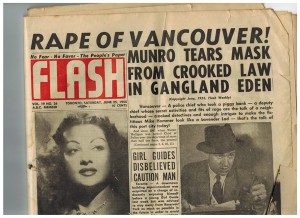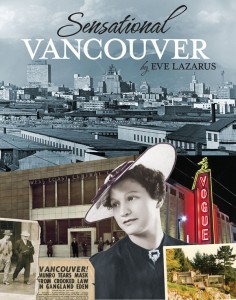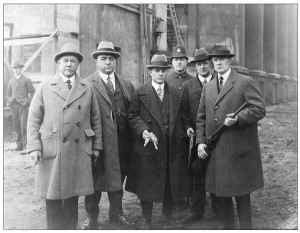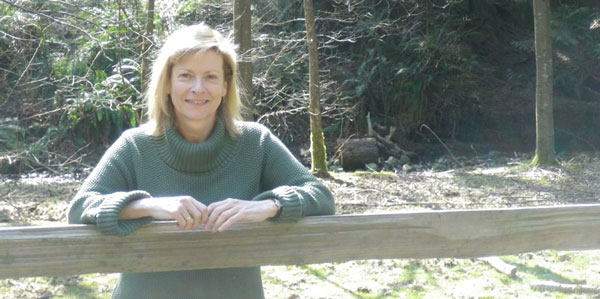
Many people live by the idea that understanding the past is critical to understanding the present, and planning for the future. Yet, at a time obsessed with ‘progress,’ history and those who write about it don’t seem to get the attention they deserve.
Well known folklorist Henry Glassie once stated that the “courageous act of history is the act of the historian who ignores most people and events while selecting a tiny number of facts and arranging them artfully and truthfully in order to speak usefully about the human condition.” And for a small and relative new region, Metro Vancouver seems to punch well above its weight in talented and engaging historians. From the late Chuck Davis to John Atkin, Jak King to Michael Kluckner, we are fortunate to house such people dedicated to telling the stories of our past.
Recently, Spacing Vancouver Editor Erick Villagomez had the great opportunity to chat with yet another one of our wonderful history buffs – journalist and author Eve Lazarus – to discuss local history, her approach to research, and her writings, including her recently published Sensational Vancouver:
Spacing: Hi Eve, thank you for taking the time to chat with us. For those who may not know who you are, can you tell us a little about yourself and your interests?
EL: I’m originally from Melbourne, Australia and I’ve lived in North Vancouver for almost 20 years. My background is in business reporting as well as news and feature writing. Over the years, I’ve worked as a staff reporter for the Vancouver Sun, as the Vancouver correspondent for Marketing Magazine, and I’ve freelanced for a bunch of different newspapers and magazines. I’m also a mother with a passion for history and heritage houses and I’ve managed to parlay those interests into several books which include Frommer’s with Kids Vancouver, At Home with History, and most recently, Sensational Vancouver.
Spacing: That’s quite a resume! (smile) Although you are being a bit modest….you’re quite a successful reporter and have won some wonderful awards, to boot. This makes me curious about you pursuing your passion in history. Clearly, given your success in journalism and corporate communications, all your writing on history and heritage houses is not critical to you making a living. Do you mind sharing how your passion developed?
EL: These days I work mostly as a “content provider” for companies such as Shaw Communications, Revamp Concepts and the Mr. and Mrs. P.A. Woodward’s Foundation. I really enjoy the work and the variety, and most of all it helps support my book and blog habit which as you astutely point out, doesn’t provide much of an income.
My interest in history and heritage houses came about by accident about 12 years ago. I’d recently visited the house where my father was born in Australia and was able to share a lot of the social history of the house with the owners through my family’s connection to it. When I got back to Vancouver I heard about James Johnstone, a house researcher who lived in Strathcona. I fell in love with this idea that a house has a genealogy like a person. I called James and interviewed him about his different projects, then I found another couple of house researchers from different parts of the country and I started to pitch these stories to magazines. I was completely stunned when every magazine I pitched—Nuvo, Style at Home, the Globe and Mail, REM and Marketing Magazine—commissioned articles. So I thought aha I have a book!
Spacing: That’s pretty much a fairy tale story. (smile) It’s wonderful to hear how everything fell into place. Now, you touched on houses being one of the main catalysts of your history work, and I know that you’ve been called the “Sherlock Holmes of home history.” Quite a comparison (smile). I find it interesting that you tend to break from the many historians that focus their attention on more ‘important’ buildings in their respective cities. Do you mind elaborating a bit more on your interest in homes as repositories of history?
EL: Actually it really didn’t fall into place. I sent out a zillion book proposals and got back a slew of responses from the standard don’t call us we’ll call you, to we love it, but we’re only doing books about gardening, or birds or kale…. After a couple of years Brian Kaufman at Anvil picked it up from his slush pile and decided to give it a go.
When I first started writing about home histories, I’d start with the house. You’d find me skulking around in the hedgerows looking up and wondering what happened inside some fabulous Shaughnessy mansion, 50, 75 or 100 years ago. Then I’d spend weeks researching only to find, not much at all. So I start with the story, and I’ve found that the best stories come out of the humble little cottages in Strathcona or Mount Pleasant or even North Van. I found that the stories that really excited me tended to fall into themes and I’ve organized Sensational Vancouver into chapters on early policing, corrupt police, brothels, bootleggers and rum-runners. It’s not all the underbelly of Vancouver’s history though, I’ve also got chapters on legendary women, entertainers and architects all filtered through the houses in which they lived.

Spacing: So it sounds like the very fact that houses were so commonplace and ‘unimportant’ triggered your curiosity to find the stories that they held. In a sense, interesting riddles waiting to be heard were all around you. I find that a really compelling and fun way to look at the everyday built environment – buildings as receptacles of human stories. In fact, now that I think about it, a lot of my favourites writers and artists have this same approach to the world.
Now, I know you brought up your most recent book Sensational Vancouver, but before we delve into that I’d like to talk about research. Most people don’t appreciate the challenges of gathering historical information. With so much at our fingertips via the internet, I find that many assume writing about local history – and gathering information that is required – to be relatively straight-forward. Only when one actually attempts to gather information do they appreciate how challenging it really is. In real terms, historians have to make sense of fragments of information.
Those historians that I have had the pleasure of meeting always comment on how piecemeal the information on our past is and, as a result, were constantly making trips to archives, talking to people and reading all types of weird and wonderful things – from old newspapers to random pamphlets – in order to dig out gems of stories and connect the dots. The late Chuck Davis’ well known – and intimidating – home archive of historical flotsam and jetsam is a case in point. Do you mind telling us a bit about your process, your approach to research, and maybe one of your most memorable discoveries?
EL: Between the time that I wrote At Home with History (2007) and Sensational Vancouver (2014), it’s amazing how much information has been digitized. It’s been a huge time saver to be able to find addresses, death certificates and photos from home for instance, rather than having to trek down to the Vancouver Public Library or the Vancouver Archives every five minutes. Where I used to have to physically drive past a house to check that it was still there, Google maps does that for me in seconds.
Having said that, I still spend a lot of my life at the Vancouver Archives, at Special Collections and on the 5th floor at the Vancouver Public Library, and at the Vancouver Police Museum and I really do love that part of the research process. Sometimes I’ll spend hours and then come away with some little nugget of information or connection and it feels like I’ve won the lottery.
One of the most rewarding and important parts of the research for me was finding people who have largely been passed over by history–legendary women such as Joy Kogawa and Valerie Jerome, and finding the relatives of other amazing women such as Nellie Yip Quong and Tosca Trasolini to share their stories.
Spacing: Those are definitely some amazing women and playing a part in sharing their stories with the world must be amazingly rewarding. You’ve referred a couple of times already to a kind of dirty, gritty history of Vancouver – brothels, corruption, alcohol and such – something very different to the sanitized history of Vancouver we often hear about. As someone constantly encouraging students of the urban environment to do historical research, I find that this type of information really resonates with younger audiences and shows the many faces history can take. Given that connecting with a younger generation seems to be one of the main challenges facing all historians and history-related institutions currently, is engaging a younger audience one of the drivers behind your writing, or simply a by-product of your interests?
EL: A reviewer once called At Home with History an “entry level book.” It wasn’t meant to be kind, but I really liked that. I’ve since found out that there is a genre called “popular history” and that’s exactly where I want my books to fit. They are not targeted at historians, or people who are interested in conventional history, they are short stories, meant to be picked up and put down, and read either in or out of sequence. We added a map of the buildings at the end of Sensational Vancouver and I really hope that people will go down to the DTES and Chinatown and walk through Strathcona and really appreciate the buildings that we have left. If this appeals to a younger reader, well then that’s just fantastic.

Spacing: This is a great segue into your books. In 2012, you published Sensational Victoria: Bright Lights, Red Lights, Murders, Ghosts & Gardens. As the title suggests, it is a grittier history of Victoria that casts the British Columbian capital in a different light than the norm. Your most recent book, Sensational Vancouver, published this past July does something similar for Vancouver. Given that you are a Metro Vancouverite, I would have assumed that the books would have been released in reverse order. What is your connection to Victoria and why did a book on your home town take so long?
EL: My first book At Home with History: the untold secrets of Greater Vancouver’s heritage homes was published in 2007. I took a slightly more academic approach to this book and most of it is organized geographically so there are chapters on homes in Shaughnessy, Mount Pleasant, New Westminster, Strathcona, etc. I loved the under reported stories about legendary women and struggling immigrants, and the ones that showed Vancouver’s grittier side. I love Victoria, it’s such an eccentric place with so many gorgeous homes that I wanted to write about it, but I wanted to do that in themes. I thought it worked really well and I wanted to develop similar themes for Vancouver – ones I skimmed over in At Home. I also wanted to bring in more voices to the conversation and add lots and lots of pictures. So in other words, Sensational Vancouver is really a sequel to At Home.
Spacing: That makes more sense now. (smile) Can you give our readers a better sense of what to expect in Sensational Vancouver? Perhaps one or two snippets of your ‘must-read ‘stories?
EL: Well Erick, I think they’re all must read stories! (smile)
Spacing: Touché. (laugh)
EL: But if I have to pick a couple of characters that I really enjoyed it would be Lurancy Harris, one of two women hired by the VPD in 1912 – and the first women police officers in Canada and Joe Ricci hired the same year as the first Italian detective—a real kick-arse guy who didn’t get to hung up on legal niceties such as warrants and evidence. I also loved writing about the corruption of the Vancouver Police Department’s chief of police in the 1950s through the eyes of Ray Munro, a kind of larger than life reporter, photographer and pilot who was good looking, arrogant and perhaps a touch insane.

Spacing: Those are definitely great stories and I found starting the book with Joe Ricci’s Vancouver a pretty intense experience. The description of the murder of Chief Constable Malcolm Maclennan literally five pages into the book was particularly irksome and, to me, set the tone for the rest of book that is quite candid about some of grittier aspects of Vancouver we’ve been discussing.
I thought the photos integrated with the content of the book also added another key dimension to the stories. They are fabulous! Although the Vancouver-we-know is shown in many, others – like the one of Ricci and other members of the VPD circa 1925 – look straight out of a New York mafia scene, characters and all! (smile) Needless to say, it was a fun, scary and eye-opening read. What do you have coming down the pipeline? Do you plan on doing similar books for other cities?
EL: I’m not planning to do similar books in other cities unless I move to one. To really dig out the stories I need to be on the ground, or at least close enough to it—I happily spent a lot of time in Victoria! I’m currently working on a book about unsolved murders in Vancouver.
Spacing: That sounds like a fun one! Well, this has been a wonderful and insightful chat, Eve. I’d like to thank you again for sharing your thoughts. Do you have any parting words….perhaps some advice for aspiring history writers or local history nerds?
EL: Follow the story!
***
Join Eve Lazarus at the book launch for Sensational Vancouver at the Vancouver Police Museum on August 12 at 7:30 p.m.
**
Eve Lazarus is a writer with a passion for history and heritage houses. She is the author of Sensational Victoria: Bright Lights, Red Lights, Murders, Ghosts & Gardens; and At Home with History: the Secrets of Greater Vancouver’s Heritage Houses. Eve blogs obsessively about buildings and their genealogies at www.blog.evelazarus.com. To find out more about Eve Lazarus and the books she has written, be sure to visit her personal website.
Erick Villagomez is one of the founding editors at Spacing Vancouver. He is also an educator, independent researcher and designer with personal and professional interests in the urban landscapes. His private practice – Metis Design|Build – is an innovative practice dedicated to a collaborative and ecologically responsible approach to the design and construction of places. You can see more of his artwork on his Visual Thoughts Tumblr.
*
Other Spacing Vancouver and Spacing interviews:
- Downtown in Transition: An Interview with Sean Bailey
- Embracing the Future: An Interview with Kobus Mentz
- Inequality, Gender, Intersectionality, Gentrification, and the City: An interview with Leslie Kern
- Talking Landscape Architecture: An Interview with Marc Treib
- Architecture and Capital in the 21st Century: An Interview with Matthew Soules
- On Interior Urbanism: An Interview with Jeremy Senko
- From Chief Planner to “Urban Ronin”? Chatting about legacy, and the future, with Brent Toderian – Part 1
- From Chief Planner to “Urban Ronin”? Chatting about legacy, and the future, with Brent Toderian – Part 2
- Optimizing Social Connection: An Interview with Saif Khan
- On This Patch of Grass: An Interview with Matt Hern, Daisy Couture, Selena Couture, and Sadie Couture
- THE ARTFUL CITY: An Interview with Sean Martindale
- Vaudeville Vancouver: An Interview with Tom Carter
- Women in Design: An interview with Johanna Hurme of 5468796 Architecture
Living History: An Interview with Eve Lazarus - Where Happiness and Urban Design Intersect
- 2012 InReview: Gregor Robertson Interview
- Malcolm Bromley & Constance Barnes Interview – Part 1
- Malcolm Bromley & Constance Barnes Interview – Part 2
- Malcolm Bromley & Constance Barnes Interview – Part 3
- Malcolm Bromley & Constance Barnes Interview – Part 4
- From Chief Planner to “Urban Ronin”? Chatting about legacy, and the future, with Brent Toderian – Part 1
- From Chief Planner to “Urban Ronin”? Chatting about legacy, and the future, with Brent Toderian – Part 2




